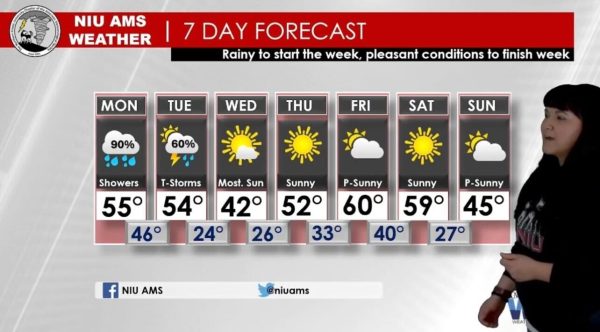Dairy farmers hit decline in profits
April 9, 2018
DeKALB — A decline in dairy prices since 2014 is negatively affecting small-farm owners.
In 2016, dairy farmers were getting 20 percent less for their milk than in 2015; 40 percent less than when milk prices hit an all-time high in 2014, according to an Aug. 5, 2016, NPR article.
Farmers continue to increase their cow herds, and in turn, more milk overflows the market to generate enough income to keep their farm running and pay off debt they may owe. The result of the milk overflow has been a decrease in dairy prices since 2014.
There are 2,300 farms in DeKalb County, 700 of which are dairy farms which produce over 14 million pounds of milk a year, according to the DeKalb Farm Bureau’s webpage.
Bill Deutsch is a fifth-generation dairy and grain farmer in Sycamore, who operates Deutsch Farms with his brother.
Deutsch said the brothers are two of just a handful of dairy producers left in the county.
Even though some farms have the ability to absorb a bad year, the below-profit prices have lasted longer in this decreased milk cycle than in the past, which may make figuring out how to remain profitable a challenge, Deutsch said.
“There is not a lot of economic advantage to getting into the dairy industry,” Deutsch said. “So, you try to increase production more to compensate, and it’s kind of a vicious cycle.”
David Meuer, owner of Meuer Farm, a 150-acre, diversified operation in Wisconsin, said farmers in Wisconsin and Illinois have both felt the impact of the price drop in dairy.
“Right now, we are on our third year of below-the-cost production price, but we haven’t seen the prices come down on the consumer really,” said Shelly Mayer, executive director for Professional Dairy Producers of Wisconsin, an education professional development organization that works with dairy farmers.
Mayer said despite having locally produced and distributed dairy farms, the money from those sales never return to the local communities.
Meuer said farmers are trying to diversify their farms because of the low prices in the dairy industry. A monoculture farm is a gamble because the farmers invest all their income in one commodity, which results in the price decline.
Because farmers look at their job as a lifestyle, it’s difficult for them to switch professions or add different production to their farms, Meuer said.
Deutsch said milk from Michigan is flowing into northern Illinois because of overproduction.
Farmers are left with limited options with either needing to discard milk or sell it for a reduced price.
Meuer said he thinks farmers turn to suicide during a difficult time.
Farmers, as a group, have a higher suicide rate than any other occupation, according to the Centers for Disease Control and Prevention.
“If you are faced with losing your farm, livelihood, your whole farm, unfortunately, some of them resorting to suicide,” Meuer said. “They realize that they’re worth more dead than they are alive, it’s sad.”
Dan Scheider, the owner of Scheidairy Farms in Freeport, said the whole industry is not in a decline; it is at the low point of a constant cycle, which is normal in agriculture.
“Prices fluctuate, so what goes up is eventually going to come down,” Meuer said.
When milk prices for dairy farmers were low in 2008, some farmers like Meuer sold off their cows because cropland is more profitable.
But in 2014 when milk prices increased to almost $28 per 100 pounds of weight, farmers reinvested in their cow herds, Meuer said.
Prices remained high for just one year because farmers continued to grow their herd and milk production, but prices have been in a decline since, Meuer said.
Deutsch said the milk prices dairy farmers receive for their product factors in the quality of the milk, which is determined after testing it. He said the components that are tested can vary dramatically based on the type of feed and breed of the milk-producing animal.
Deutsch said he receives a high premium for milk because it contains above average fat protein. He said his prices are closer to $17 per 100 pounds of milk.
“If the milk quality is higher, they might receive an increase price for that milk,” Deutsch said.
Meuer said the price decline coming to an end depends on if a rain drought occurs like it did back in 2014. Farmers will have to start liquidating cows, which would help cut down on milk production.
“It’s marketing,” Meuer said. “When the prices are good, the people get greedy. They want to expand and expand and don’t think back or don’t remember three years or five years before that when prices were really bad.”
Scheider said a long-term solution could be focusing on trade in a global market.
“The people around the world appreciate and respect our products,” Scheider said. “But if our government gets in the way of trade, that’s not going to help correct any marketing issues, and there is a potential that it can become worse.”
Meuer said the government needs to control and cut down the milk production, possibly with a quota system. He said other countries are not taking the milk as imports because they already have a system for their commodities in place.
“The price that we are receding on farms is very low not only there is the surplus but there is a lot of trade agreements that are being discussed and distributed,” Mayer said.
Mayer said it is important for the farm families that are being challenged and under stress to remember to take care of one another and encouraged farmers to prioritize their focus on the things that they can control and show some leadership.
“Farmers can’t control the prices that they are getting but can control the care they give,” Mayer said. “The quality of the product they produce and ultimately the message you give the the next generation about what the futures going to look like.”













